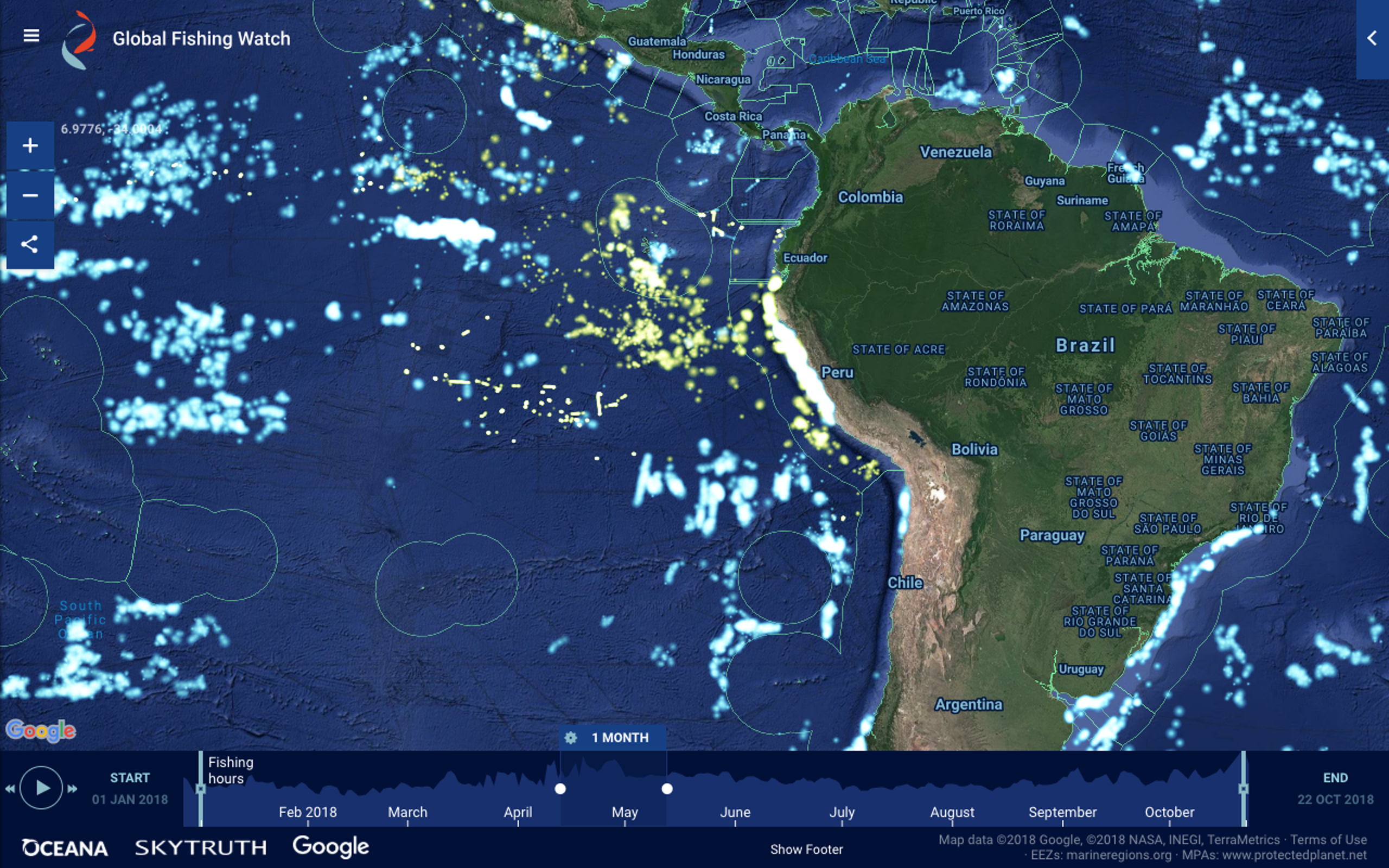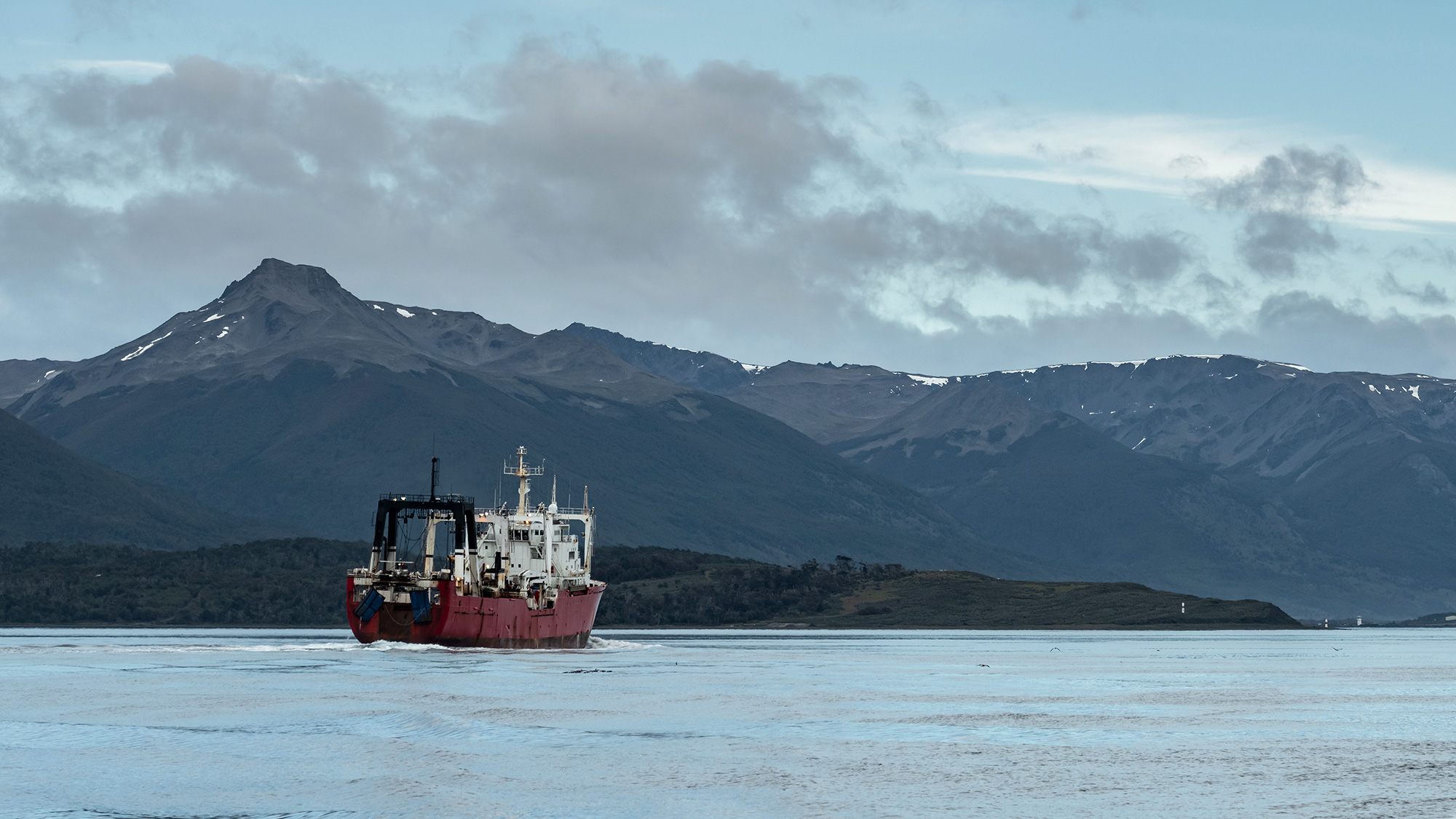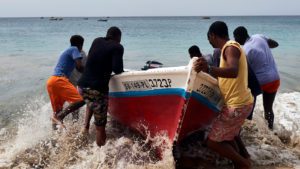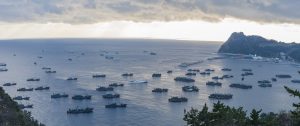Our Shared Seas checked in with Margot Stiles, former Program Director at Global Fishing Watch, to review recent advances in fisheries transparency through country commitments and developments in satellite technology.

Vessels tracked with Global Fishing Watch’s AIS data are seen in blue. The addition of Peru’s VMS data, shown in yellow, instantly put 1,300 of their industrial fishing vessels on the map. Most of these vessels are not active on AIS, therefore, for Peru alone, that represents a ten-fold increase in the number of vessels that are now publicly trackable via Global Fishing Watch. Credit: Global Fishing Watch
The concept of visualizing all global fishing activity—both industrial and small-scale—was out of reach less than a decade ago. Given dramatic advances in satellite technology and machine learning, Global Fishing Watch has turned big data into actionable information to provide unprecedented transparency of human activity at sea. In turn, this transparency has facilitated an entire new field of scientific research and is supporting the organization in its efforts to monitor the activity of all large industrial vessels at sea, including those vessels operating outside the law. A key component of this work has included partnerships with national governments that have shared their vessel tracking data on the Global Fishing Watch platform to increase fisheries transparency and bolster fisheries management.
Global Fishing Watch has signed agreements with several countries that have committed to sharing vessel tracking data to promote fisheries transparency and strengthen management. Can you offer a status update on how many countries have made these commitments and whether it is translating to improved fisheries management on the water?
Momentum for transparency continues to build during the pandemic, and Global Fishing Watch is close to reaching the first milestone of 10 countries committed to transparency. In April 2021, Brazil announced its commitment to transparency. Global Fishing Watch is actively receiving data from five countries, including Chile, Costa Rica, Ecuador, Panama, Peru; three countries have committed and still need to send data; and three countries are close to adopting transparency.
We have seen numerous examples of transparency benefiting management. For example, Panama is using Global Fishing Watch data and tools to check the history of vessels on its registry before approving their license renewal.

Fishing boat sailing between Argentina and Chile. Photo: iStock/nickalbi
There has been significant global momentum in the drive for fisheries transparency in recent years. What would the Global Fishing Watch team like to see from governments in the coming years? Can you describe the potential of this work?
Growing momentum for transparency is good news for every government facing economic losses due to illegal, unreported, and unregulated (IUU) fishing. We see international cooperation on data sharing as a key part of the solution to this problem and would like to see governments drawn on the powerful combination of technology and transparency in their daily management decisions. We have been inspired by the leadership of Chile’s Alicia Gallardo in sharing her country’s experience with transparency with her peers in Brazil. These conversations go a long way in adapting these general concepts to the specific needs of each government.
Growing momentum for transparency is good news for every government facing economic losses due to illegal, unreported, and unregulated (IUU) fishing. We see international cooperation on data sharing as a key part of the solution to this problem and would like to see governments drawn on the powerful combination of technology and transparency.
We are in the midst of a data revolution in the ocean which has made monitoring fishing activities, both at scale and in real-time, possible in ways that were unimaginable even a few years ago. The Global Fishing Watch team has been at the cutting-edge of this field in leveraging satellite technology and big data processing. What is on the horizon in the coming years?
The availability of mobile network connectivity, data processing, and analysis enhanced by machine learning continue to advance at a dizzying pace. In many fields, the outstanding challenge has been in adapting human behavior and management practices to thoughtfully leverage this new pipeline of information.
Global Fishing Watch seeks to build tools for the data streams that will be available in a few years. Right now the team is exploring how to combine its original technology for interpreting vessel movements with a wide range of ocean data streams, and how to make the results more easily accessible in low-bandwidth areas and on smartphones, since people around the world increasingly access the internet through mobile devices.
Data insights from Global Fishing Watch have made entire new fields of scientific research possible. What is the role of open data in making the case for better governance, and have you seen examples in which building the evidence base has informed decision-making around fisheries management?
Open data can enhance many fields of governance. We have seen it during the pandemic, as citizens access public data on testing and vaccination rates in order to keep their families safe. For ocean governance, Global Fishing Watch and our partners have demonstrated that having the evidence readily at hand makes all the difference. Even though our government partners already had access to their own data, in practice they have found that displaying key summary information through Global Fishing Watch makes it easier to use. For its part, the U.S. Coast Guard has even found it easier to plan patrols using our platform rather than through traditional means.
Open data is accessible faster than classified data and can be more easily shared across agencies and between governments. This facilitates increasing enforcement cooperation across national boundaries and plays an important complementary role in helping to manage what is increasingly a transnational governance need.
Shifting to impacts on the ground, what is the vision for how Global Fishing Watch programs will ultimately benefit communities that depend on fisheries resources for their livelihoods and food security?

Photo: FAO
Global Fishing Watch is exploring potential partnerships to apply our technology and datasets more directly to the needs of coastal communities and small-scale fishers by addressing the overwhelming lack of data for this sector. It is clear we must do more to support fishing that provides food and livelihoods for people in remote areas, who are often the most vulnerable to economic shocks, including from climate change and other threats. The organization is seeking input on which new visualizations are needed to support those working to enhance fishing livelihoods and food security.
Global Fishing Watch is exploring potential partnerships to apply our technology and datasets more directly to the needs of coastal communities and small-scale fishers by addressing the overwhelming lack of data for this sector. It is clear we must do more to support fishing that provides food and livelihoods for people in remote areas.
Beyond partnering with governments and academics, do you see a role for industry in driving improvements in fisheries management and transparency?
There is definitely a role for industry leaders to demonstrate how transparency can be incorporated into mainstream business practice. The Open Tuna project in Brazil has voluntarily adopted transparency for the longline tuna fleet operating out of Northeast Brazil, sharing data freely on Global Fishing Watch as of spring 2021. Their industry association is combining transparency, traceability, and research to give their U.S. customers greater confidence in where their tuna comes from.



